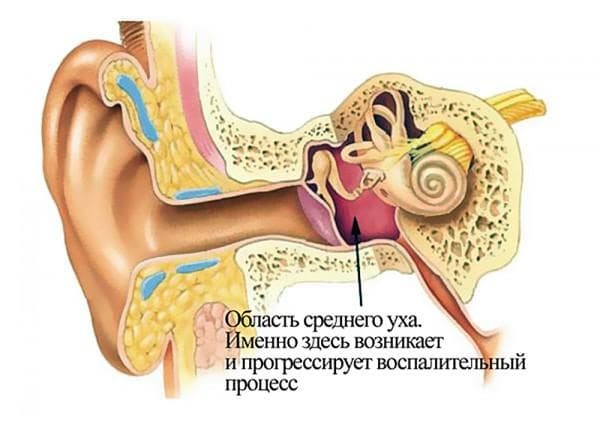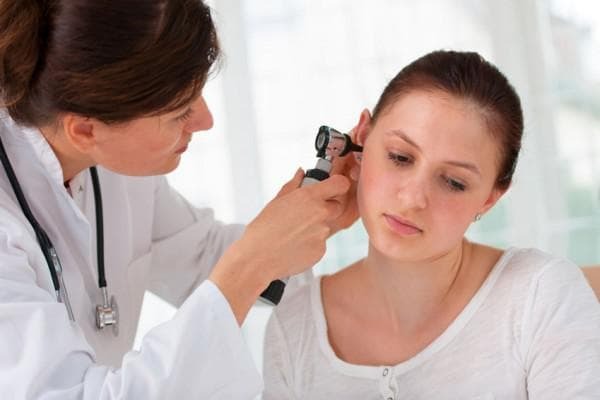
Chronic adhesive otitis media of the middle ear is a serious inflammatory disease that can lead to complete or partial hearing loss. A characteristic feature of the disease will be the formation of adhesions and cords, the deterioration of the permeability of the auditory canal and the mobility of the bones that create the structure of the hearing aid. All this is accompanied by a sharp deterioration of hearing and painful sensations. If the slightest suspicion arises, immediately consult a doctor - an otolaryngologist for further diagnosis and treatment.
Contents
- 1 Causes of
- 1 Causes of
- 2 Diagnosis of
- 3 How to treat
Causes of
Among the most common factors of the onset of the disease can be considered the transferred ENT diseases, congenital anatomical features of the structure of the auditory canal and many other reasons. Often the disease is "masked" for normal otitis and the true nature can be recognized only by a specialist after extensive research. There are described the symptoms and treatment at home of different types of otitis media. The link describes the signs of otitis in the baby.

Causes of the development of this disease:
- Consequences of the inflammatory processes of the hearing aid.
- Uncontrolled antibiotic treatment and treatment.
- Acute forms of ENT diseases.
- Seasonal exacerbation of sinusitis.
- Complications after sinusitis or even ordinary rhinitis( cold).
- Curvature of nasal septum( congenital or acquired).
- Adenoids.
- Polyps and tumors of the nasal cavity or pharynx.
- Frequent inflammatory processes that are carried over without proper treatment.
- Dental problems.
The video tells in detail about the adhesive otitis:
The best prevention of this disease will be the professional help of the doctor for all types of ENT problems, as well as the refusal of ill-considered treatment with antibiotics. All medicines must necessarily be coordinated with the attending physician, otherwise there is a risk of severe consequences not only for the hearing organs, but also for the functioning of the whole organism as a whole. Possible treatment of otitis antibiotics in adults is described by reference.
Diagnosis
As mentioned earlier, it is only an expert who will be able to determine the adhesive otitis accurately, with several examinations to exclude other variants and an accurate diagnosis.
Measures for the diagnosis of adhesive otitis:
- Inspection of a doctor - an otolaryngologist.

- Performing audiometry - a special procedure consisting in "blowing" the auditory canal using the method of the Politzer. If there is another disease, purging guarantees a very effective effect, and in the case of an adhesive otitis media, there will be virtually no result.
- Otoscopy is an enlarged examination that allows you to see exactly the possible adhesions or scar changes in the structure of the middle ear.
- Determination of the degree of patency of the auditory canal.

- Acoustic impedance measurement is also a very useful test, determining the mobility of the auditory ossicles and the degree of dilatation of the tympanic membrane. If the normal operation of the hearing aid is impaired, the elongation of the membrane is limited or absent altogether, it can be concluded that there is an adhesive otitis.
Do not be afraid to undergo a complete examination, because that's how you can create a complete picture of the disease and determine its severity and future prospects. In the absence or incomplete treatment, the threat can be a complete loss of hearing, as well as the progression of the disease and the defeat of other organs. The results of all special examinations will confirm or refute the diagnosis of "adhesive otitis", which will allow the doctor to write out a treatment plan.

Find out if you can do a compress with purulent sore throat.
What does it mean if the throat hurts, the rhinitis and lays the ears?
Reviews on the use of milk with a cough syrup: http: //prolor.ru/g/lechenie/ inzhir-s-molokom-ot-kashlya-recept.html.
How to treat
What is the treatment regimen for otitis in this disease? In order to get rid of the disease in the first place, it is necessary to remove the provoking factor. For this, medicinal treatment is attributed. In the case of a pathological structure of organs, surgical intervention is required. To the causes that led to the disease can be attributed to any kind of infection, so it may be necessary to completely sanitize the oral cavity, nasal sinuses and larynx. Children may require removal of adenoids, but only in case of emergency, if other treatments are ineffective. Curvature of the nasal septum can also cause adhesive otitis media, so it is necessary to remove this factor.
The second stage: manipulation with the help of special equipment. According to the treatment plan, this is usually a blow on the method of the Politzer, already mentioned earlier as diagnostic measures. The difference is the simultaneous carrying out of the pneumomassage of the tympanic septum and the introduction of special medications in the auditory canal.
The video tells how to treat and cure adhesive otitis:
Physiological procedures are also very effective. It can be UHF - heating, microwave therapy, ultrasound massage and even mud therapy. All these procedures do not abolish drug treatment, but they provide a complex effect and help to cope with the disease more quickly.
Patients are recommended to take multivitamins during treatment, especially group B. This measure promotes better progress and recovery. In order to avoid allergic manifestations, you should also take antihistamines.
Home methods, unfortunately, are not suitable for the treatment of adhesive otitis, moreover, they can cause disease progression and severe consequences, so you should not take risks. Additional measures, like warming up the "blue" lamp, the introduction of tampons with various home-made decoctions and mixtures must necessarily be agreed with the doctor.
Some "grandmother's" methods for treating the inflammation of the middle ear can alleviate the symptoms of the disease and enhance the effectiveness of official treatment. The main requirement is that all activities should be coordinated with the attending physician, and not with the advice of "knowledgeable" people without proper qualification.
On the video - the review "How I cured adhesive otitis":
Surgical methods of treatment of adhesive otitis are the excision of scars on the surface of the auditory ossicles. This is an extremely complex and unpredictable procedure, the implementation of which does not guarantee the restoration of the work of the body. Often, such operations do not bring tangible benefits and require prosthetics of some elements. Especially disappointing prognosis for the youngest patients: in children, such operations are almost not carried out because of the high risk of repeated scarring of tissues. This deprives the cost of expensive and dangerous surgical intervention.
The main danger of adhesive otitis is the irreversibility of the existing changes. Treatment can only stop the progression of the disease, but not return the body to its original state. With timely treatment it is possible to avoid complete deafness, but the acuity of hearing will still be a little lost.
Adhesive otitis media of the middle ear is a serious disease, the treatment of which must be treated with all responsibility. Correct diagnosis and timely access to a specialist will help to stop the disease in time, but it was not possible to completely restore the affected organ. Perhaps you will also be useful information about the symptoms of catarrhal otitis. The link describes ear drops in otitis in adults. And here you will find children's ear drops during otitis.
